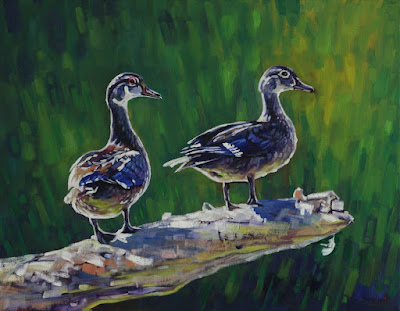 |
| #2851 "Water Stalker" 20x16 inches oils on canvas Started April 10th, 2024 |
A very large great blue heron was on the rocky shore of Jim Day Rapids when Linda and I visited the Singleton Sanctuary for the very first time. We would purchase the land a few weeks later. It was a dream come true. That great blue heron and its descendants would always be safe within the Sanctuary. The pictures below show how the land looked in 2006 and it still looks the very same except for the inclusion of our home. The upper right shows Linda with Real Estate Bill looking at maps. I fell in love again while Linda tells Bill "this is it..." Linda could read my body language from 100 yards. Although I was born and raised in the area, it was like John Denver's "Rocky Mountain High" where he sings about "coming home to a place he'd never been before". It was a special moment and we now live that every day.
The Great Blue Heron is the largest heron in Canada. Adults stand over 3 feet high with their necks outstretched. The long limbs dictate the heron's movements: it flies with deep, slow wing beats, and on land, or in the water, it walks erect with long strides. In flight, the neck is doubled back, the head resting against the shoulders, and the long legs held straight behind (see below).
This colonial-nesting waterbird is characterized by its long neck, long legs and short tail, and a greyish-blue upper body with black and white markings on its crown and underparts. The most obvious difference between a male and female great blue heron is size. Male herons are visibly larger than their female counterparts, typically weighing between 6 and 8 pounds. A female usually weighs between 4 1/2 and 6 pounds. The male heron's bill is longer than the female's bill. These differences are most visible when a mating pair sits side by side. The ornamental plumage in males has been found to be longer on average as well, but these differences can be hard to discern. Young herons tend to have much darker feathers on their face, neck and crown. I am guessing that this is a young male great blue heron but not really certain.The males and females play different and distinctive roles in the heron mating ritual. Herons form mating colonies in May and June. Within a colony, herons break off into breeding pairs that remain together and monogamous during the breeding season. Males in the colony perform for the females, flying large circles over the nesting ground, calling loudly, and fighting with other males who challenge their courtship for the female of their choice. Females tend to remain in a single location during the mating ritual, calling the males to her with her song and waiting for the right partner to come to her. They share the responsibility of rearing young.
Great Blue Herons have specialized feathers on their chest that continually grow and fray. The herons comb this "powder down" with a fringed claw on their middle toes, using the down like a washcloth to remove fish slime and other oils from their feathers as they preen.
The great blue heron's stilt-like legs are essential for foraging in shallow waters where the birds feed on fish and frogs. On land, being a generalist and opportunistic species, great blue herons may hunt for salamanders, smaller birds, reptiles, other small mammals and large insects.
Other fun facts:
- The scientific name is Ardea herodias.
- There are five subspecies of great blue heron.
- They breed in colonies called heronries.
- The young birds are fed by both their parents via regurgitation.
- They typically lay 3-5 eggs.
- Their nests are sometimes more than 100 feet up in a tree.
This is another image taken by my friend, John Verburg, a naturalist and terrific photographer. John provides a tremendous source of inspiration during the winter when the windchill encourages me to stay within the Singleton Studio. The title is a bit of a play on words. "Water Walker" was a phrase used by the canoeist Bill Mason which was possibly a spoof of the popular movies based on "Luke Sky Walker". I frequently contemplate the phrase "water walker" when I paddle. The great blue heron is famous for stalking the shallows for tasty meals...
I use these art posts to also relearn or discover for the first time, some natural history facts about the world around us. It is more of a challenge to assist and preserve something that one does not understand or appreciate. Thank you for reading this far... Education is a way of life and may it never get old.
For this and much more art, click on Pixels or go straight to the Collections. Here is the new Wet Paint 2024 Collection.
Warmest regards and keep your paddle in the water,
Phil Chadwick











_The_Dock_of_the_Bay_by_Otis_Redding_US_vinyl.jpg)





















